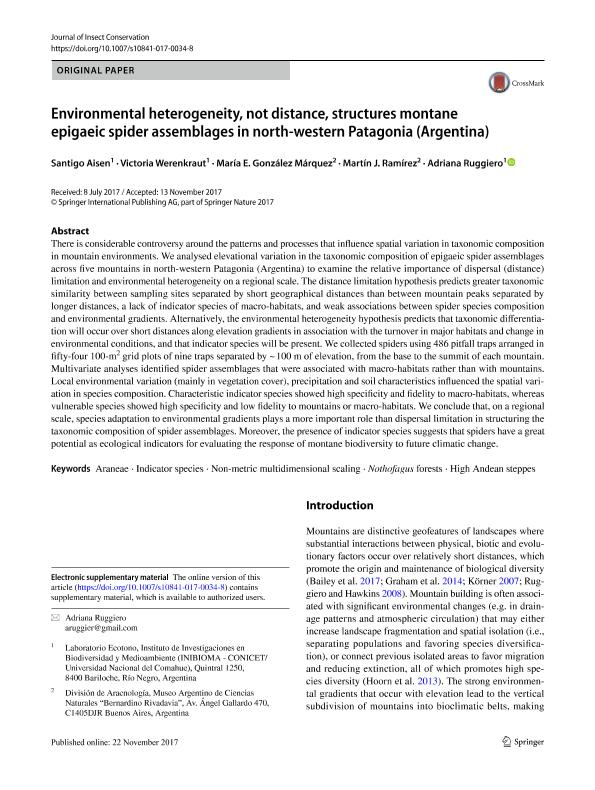Artículo
Environmental heterogeneity, not distance, structures montane epigaeic spider assemblages in north-western Patagonia (Argentina)
Aisen, Santiago ; Werenkraut, Victoria
; Werenkraut, Victoria ; González Márquez, María Eugenia
; González Márquez, María Eugenia ; Ramirez, Martin Javier
; Ramirez, Martin Javier ; Ruggiero, Adriana
; Ruggiero, Adriana
 ; Werenkraut, Victoria
; Werenkraut, Victoria ; González Márquez, María Eugenia
; González Márquez, María Eugenia ; Ramirez, Martin Javier
; Ramirez, Martin Javier ; Ruggiero, Adriana
; Ruggiero, Adriana
Fecha de publicación:
12/2017
Editorial:
Springer
Revista:
Journal of Insect Conservation
ISSN:
1366-638X
e-ISSN:
1572-9753
Idioma:
Inglés
Tipo de recurso:
Artículo publicado
Clasificación temática:
Resumen
There is considerable controversy around the patterns and processes that influence spatial variation in taxonomic composition in mountain environments. We analysed elevational variation in the taxonomic composition of epigaeic spider assemblages across five mountains in north-western Patagonia (Argentina) to examine the relative importance of dispersal (distance) limitation and environmental heterogeneity on a regional scale. The distance limitation hypothesis predicts greater taxonomic similarity between sampling sites separated by short geographical distances than between mountain peaks separated by longer distances, a lack of indicator species of macro-habitats, and weak associations between spider species composition and environmental gradients. Alternatively, the environmental heterogeneity hypothesis predicts that taxonomic differentiation will occur over short distances along elevation gradients in association with the turnover in major habitats and change in environmental conditions, and that indicator species will be present. We collected spiders using 486 pitfall traps arranged in fifty-four 100-m2 grid plots of nine traps separated by ~ 100 m of elevation, from the base to the summit of each mountain. Multivariate analyses identified spider assemblages that were associated with macro-habitats rather than with mountains. Local environmental variation (mainly in vegetation cover), precipitation and soil characteristics influenced the spatial variation in species composition. Characteristic indicator species showed high specificity and fidelity to macro-habitats, whereas vulnerable species showed high specificity and low fidelity to mountains or macro-habitats. We conclude that, on a regional scale, species adaptation to environmental gradients plays a more important role than dispersal limitation in structuring the taxonomic composition of spider assemblages. Moreover, the presence of indicator species suggests that spiders have a great potential as ecological indicators for evaluating the response of montane biodiversity to future climatic change.
Archivos asociados
Licencia
Identificadores
Colecciones
Articulos(INIBIOMA)
Articulos de INST. DE INVEST.EN BIODIVERSIDAD Y MEDIOAMBIENTE
Articulos de INST. DE INVEST.EN BIODIVERSIDAD Y MEDIOAMBIENTE
Citación
Aisen, Santiago; Werenkraut, Victoria; González Márquez, María Eugenia; Ramirez, Martin Javier; Ruggiero, Adriana; Environmental heterogeneity, not distance, structures montane epigaeic spider assemblages in north-western Patagonia (Argentina); Springer; Journal of Insect Conservation; 21; 5-6; 12-2017; 951-962
Compartir
Altmétricas



